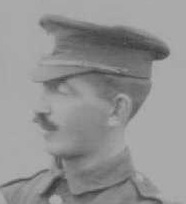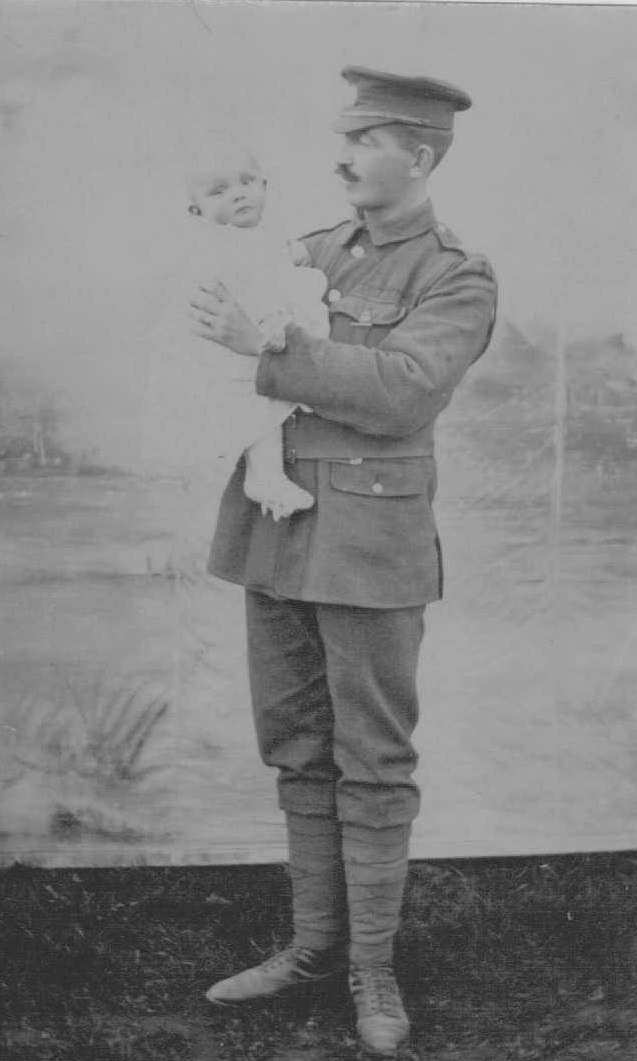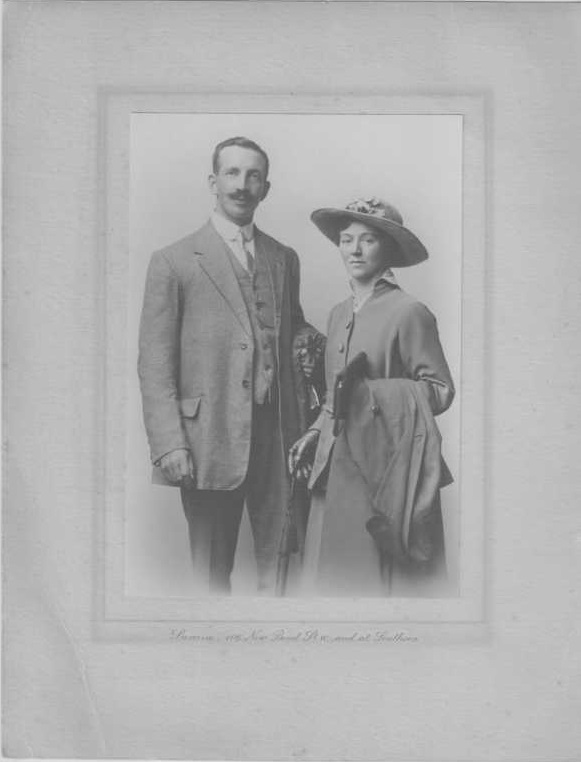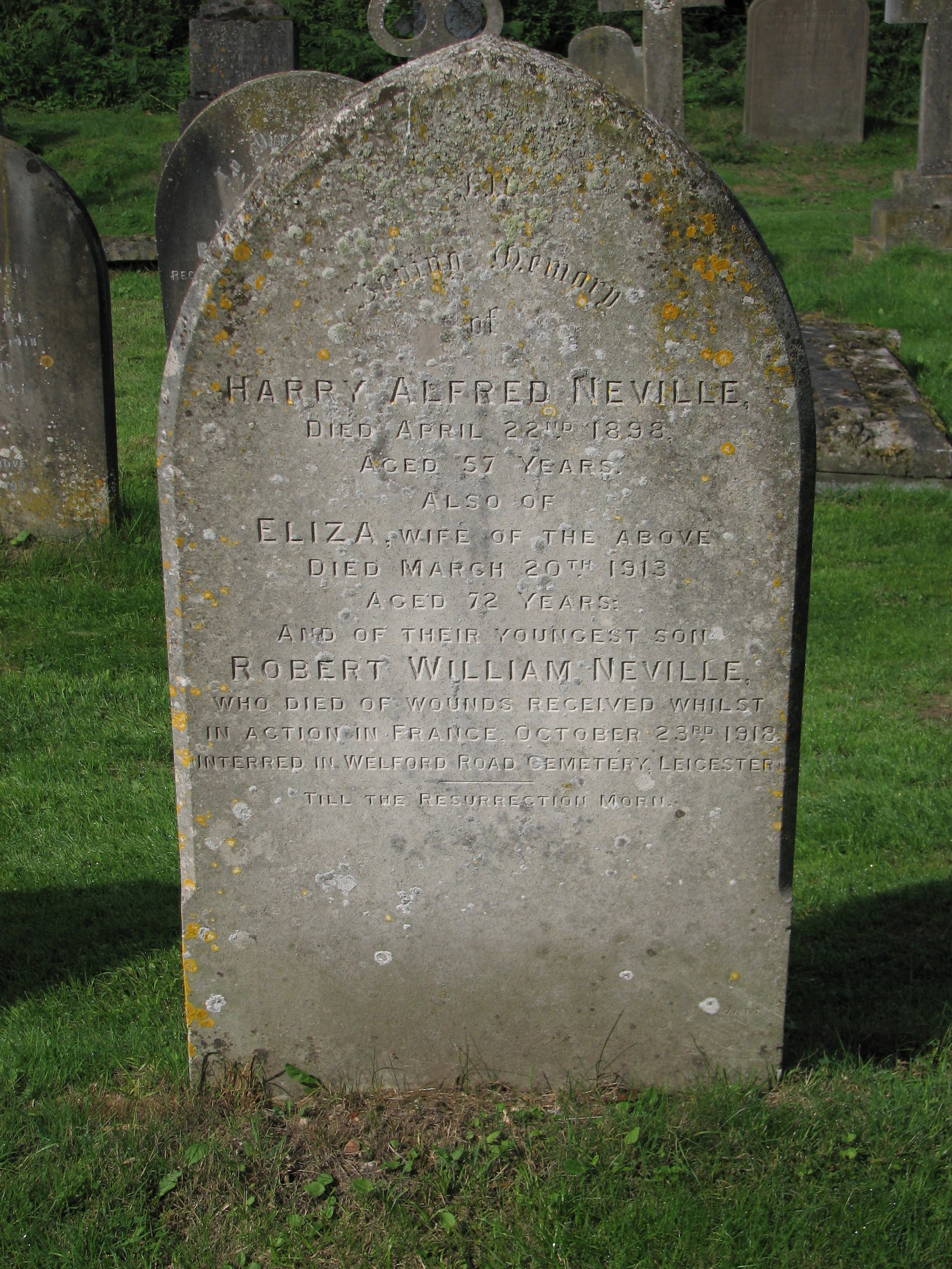Robert Neville (1881 - 1918)
Robert left the village as a young man and moved down to Hampshire. He served for 15 months on the Western Front before being seriously wounded. Robert died of his wounds two months later, leaving a wife and young son.
- 48
- Died in the Great War
- 51.97158, 1.009487
Details
| Name: | Robert William Neville |
| Service: | British Army |
| Unit: | 2nd Battalion, Coldstream Guards |
| Regimental Number: | 19783 |
| Rank: | Private |
| Date of Death: | 23rd October 1918 |
| Age: | 37 |
| Buried: | Screen Wall O1. 208, Leicester (Welford Road) Cemetery |
Family Background and Early Life
Robert Neville was born in East Bergholt on 28th July 1881, most likely at his parents’ home on Cemetery Lane.
Robert’s father Harry Neville, was a Blacksmith – like his father before him – and a Bergholt man born and bred. 1 It is reported that the iron gates which still grace the main entrance to the village cemetery were made by the Nevilles. Given the date that the Cemetery was consecrated (1856) it is perfectly feasible that both Robert’s father and his Grandfather could have worked on these. In 1870 Harry married Eliza Sage, who was also from East Bergholt, and together they had 5 children, all of whom survived to adulthood. Robert was the youngest child.
Harry Neville died at the age of 53 when Robert was 16. 2 Robert’s mother passed away in March 1913, and was buried with her husband in East Bergholt Cemetery. Whether Robert had already left home by this time is not known, but by April of 1901 he was living with his married sister Annie and her family in Stratfield Saye, Hampshire. Annie’s husband George Middleton was a Grocer and Butcher in the village, and he was almost certainly employing Robert, whose occupation at that time was given as Grocer’s Clerk.
By April of 1911, Robert was living in the Hampshire village of Baughurst and was a self-employed Butcher. The Butcher’s business may not have been successful, as by late 1915 he was employed as a Canteen Steward at the Sling Army Camp, near Bulford on Salisbury Plain.
The Group Scheme
Robert joined the British Army under the Group Scheme on 12th December 1915. 3 More commonly called the Derby Scheme, after Lord Derby, the Director-General of Recruiting. This was effectively a last ditch attempt by the government to increase recruitment by voluntary means, before they had to resort to conscription.
Robert formally enlisted and joined the Army Reserve, but as permitted under the terms of the Group Scheme, he then chose to go back to his civilian occupation until he was required.
On 25th August 1916, Robert married 32 year old Maude Street at the Parish Church in Silchester, Hampshire. Maude had been born in Portsmouth, but appears to have been living in Silchester for some years where she acted as a Housekeeper at Lower Farm, for her uncle Walter Street.
Robert was called up on 23rd October 1916, and posted to the 5th Battalion of the Coldstream Guards initially based at Caterham, and later at Windsor. The 5th was the Coldstream’s Reserve Battalion, used primarily to provide replacements for the Regiment’s battalions in France.
France
Robert was sent to France on 26th May 1917. He was initially posted to the Regiment’s 4th Battalion, who were the Pioneers to the Guards Division. The Pioneer Battalions were all armed as infantry soldiers but were intended to support the Royal Engineers in a variety of tasks. 4 Each division had a Pioneer Battalion. “Intended to provide the Royal Engineers, with skilled labour and to relieve the infantry from some of its non-combatant duties, Pioneers became the work horses of the Expeditionary Forces. Several New Army battalions were raised specifically as Pioneers, while others were converted Territorials or Kitchener units formed originally as conventional infantry. Adopting a badge of a cross rifle and pick, these battalions wired, dug and reverted [sic] in all weathers and in all terrain. On many occasions they abandoned their working tools and fought alongside the infantry in repelling enemy attacks.” – extract from “Pioneer Battalions in the Great War” by K.W. Mitchison, Pen and Sword 2014.
For most of the time that Robert was with the 4th (Pioneer) Battalion, they were based a few miles behind the front of the Ypres Salient. In their duties they often went close to or even into the front line trenches. It was not easy work, and casualties were not uncommon.
Just one month after Robert went to France, Maude gave birth to a son, who they called Ralph William.
On 12th August 1917, Robert was posted to the 2nd Battalion of the Coldstream Guards. The 2nd were an infantry battalion, and had only recently been involved in the fighting at the start of the Third Battle of Ypres. 5 Another East Bergholt man was already serving with the 2nd Coldstream Guards when Robert joined – John Dale from Box Iron. Whether Robert and John met whilst they were in France and Belgium is not known. It is not inconceivable however, as Robert still had a brother and sister living in East Bergholt, and he may well have corresponded with them.
John Dale was killed in action on 30th November 1917, during the Battle of Cambrai, aged 20. He has no known grave and is commemorated on the Cambrai Memorial.
During the time that Robert was with the 2nd Coldstreams, they fought in the Third Battle of Ypres (commonly referred to as Passchendaele) in the summer and autumn of 1917, the Battle of Cambrai in November 1917, and the Battle of St. Quentin in March 1918.
Throughout much of July and August 1918 the Battalion were positioned approximately midway between Arras and Bapaume. They rotated with other battalions every 6 days, manning the trenches: 6 days in the front line at Hamelincourt, followed by 6 days in the Reserve trenches at Ransart and then 6 days in the Support trenches at Hendecourt, before starting the cycle again. On most days the Battalion suffered casualties.
“The Hundred Days”
On 8th August 1918 the British had launched a limited – albeit extremely successful – offensive near the city of Amiens, thirty miles to the south of the 2nd Coldstream positions.
History now sees this as marking the start of what is called “The Hundred Days”, a series of victories for the Allies which culminated in the Germans suing for peace and the signing of the Armistice on 11th November.
In late August, the British launched two more offensives, one of which was in the Guards sector. On 27th August, the Battalion attacked from the front line trenches at St Leger: They gained their objective, killing and capturing large numbers of the enemy in the process, before being beaten back with heavy losses. The 2nd Coldstream Guards suffered 310 casualties in the attack, including 114 dead; this left just 140 men of all ranks remaining in the Battalion. The objective was finally captured by another unit that evening.
The following day, the 2nd Coldstreams “followed up the German Retirement and consolidated their positions” before being relieved that night. Their casualties were 1 man killed and 3 men wounded.
At some point on either 27th or 28th August, Robert was seriously wounded in the right leg. The wound was so severe that the leg had to be amputated at the thigh. 6 In a Death Notice which appeared in a local newspaper, it is stated that Robert had been wounded on 28th August. Whilst this is distinctly possible, it was not unknown that casualties which occurred on one day might be reported in some channels as having occurred the following day -especially after heavy fighting.
Robert remained at one of the hospitals in France until 19th October, when he was evacuated to England. He was then admitted to the 5th Northern General Hospital in Leicester.7 Some of the hospital buildings still survive, and form part of the University of Leicester. Robert died of his wounds there, on 23rd October 1918.
Robert was buried in the war graves plot of Welford Road Cemetery, which was adjacent to the hospital. His grave is not individually marked, and so his name appears on the screen wall which is situated in the plot.
Postscript
Maude Neville never remarried. She died in 1944 at the age of 60.
Acknowledgements
I am very grateful to Mrs B. Neville (Robert’s Granddaughter-in-law) for her kind permission in allowing me to include the family photograph’s here.
Copyright © Mark Ashmore, 2024
- 48
- Died in the Great War
- 51.97158, 1.009487




